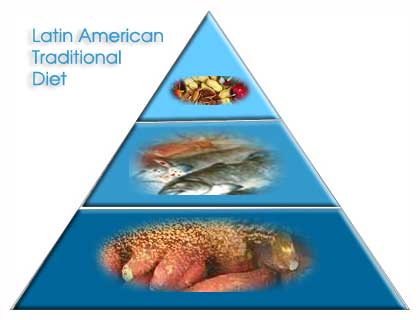Confusion in the literature
The epithet "Latin American" is used for convenience only, and is meant to outline this area of the Americas conquered and settled by Spanish and Portuguese speakers. Therefore, it includes almost all lands from Mexico to Tierra del Fuego or Patagonia.
The most important food crop the newcomers found was undoubtedly what we now call maize. But to the "Pilgrim Fathers" who landed on "Plymouth Rock," this was simply another grain from which to make bread and porridge. The old English name for all grains was "corn." To distinguish the new crop they called it "Indian corn." Soon the ethnic epithet was dropped and maize came to be known as corn, creating not little confusion in the literature on food and cooking.
The grain staples
Maize is known from about the 6th millenium BC on the Tehuacan highlands and the tropical lowlands of Yucatan in Mexico. At Columbus's time, there were already some 200 varieties of maize, what some believe may be one of the most remarkable plant breeding feats in history.
Another important ancient grain is quinoa, meaning "mother grain," a staple food of the Incas. It is a white, round, sesame-like grain that grew from Colombia all the way to southern Chile, which can be cooked like rice with a mild taste and fluffy texture, or made into bread. It possesses several advantages over maize. It can be grown at high altitudes, and it constitutes one of the richest sources of protein (16%) in the plant kingdom, richer even than soybeans, with a high fiber content. Equally, both the grain and its tender leaves may be eaten, with the grain providing carbohydrates and protein, the leaf the vitamins and minerals we associate with vegetables.
A third valuable grain was amaranth. Called kiwicha by the Incas, it has perhaps even more advantages than quinoa. It is highly resistant to drought, heat and pests, and at the same time is adaptable to different latitudes and environments and hence cultivated as widely as maize. It is a high protein food, with 2-3 times the lysine and larger amounts of methionine and cysteine than other grains. The leaves of the plant contain twice the calcium of spinach and more than other plants.
And a remarkable thing about all major native American grains, that is, maize, quinoa and amaranth, none of them contain gluten, the protein complex that makes bread fluffy but also causes the food allergies and intolerances associated with wheat and rye products.
A problem with maize, but not the other two grains, is the lack of niacin or vitamin B3 in the grain. It caused pellagra, or scaly dermatitis with complications of diarrhea and mental depression in maize eating countries, before pellagra was recognized as a nutritional disease. The ancient Americans prevented the disease by treating maize with lime, or some other alkaline substance like wood ash. This treatment added calcium to maize, while at the same time some niacin and the amino acids lysine and tryptophan became more bioavailable. Tryptophan is readily converted in the body to nicotinic acid that is a synonym for niacin. Briefly, pellagra became a risk of maize eating, but mainly because the Europeans did not grasp the purpose of lime treatment.
The root staples
Undoubtedly, the most valuable crop to have come out of the Americas is potato. Its value in a European context was especially felt when grain crops failed, and in northern countries during the winter months, when vegetables and fruits became scarce and so did vitamin C. Potatoes were grown in the Peruvian highlands from as far back as the 8th millennium BC, from where they spread to the rest of the Americas and from the 16th century to the rest of the world.
Sweet potatoes seem to be another root crop originating in the Americas, with a large amount of starch, three times the beta-carotenes (provitamin A) of carrots, and a reasonable amount of vitamin C.
The legumes
The beans of the Phaseolus family are also of American origin. Named according to what most struck the European invaders, Lima beans were so named because they were first seen near Lima, Peru. The Anasazis took their name from the Anasazi Indians of the southwestern US. The kidney beans from their shape; while the pinto beans with their pale pink and reddish-brown streaks, because they looked as if they had been painted (Sp pinto).
Together with the Phaseolus family of beans, two other beans were cultivated in ancient southern America. One was the Tarwi bean, with about 50 percent protein and a rich store of lysine. The other was the Nuna bean, grown at high latitudes and readily cooked in a few minutes.
|
Vegetables, fruits, seeds and nuts
Tomatoes, high in the powerful antioxidant lycopene; green bell peppers rich in vitamin C; avocados with lots of monounsaturated fatty acids like the olive; cocoa with stearic acid, the only saturated fat that is not harmful; papaya and pineapple with proteolytic enzymes; melon pears and other fruits of the nightshade family; peanuts with good protein, unsaturated fats, lots of B vitamins and magnesium; many pumpkins and squashes with pumpkin seeds containing important amino acids, fatty acids and minerals like zinc, are all of American origin.









